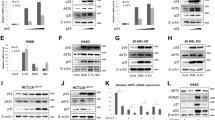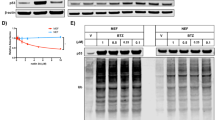Abstract
The p53 tumour suppressor promotes cell-cycle arrest or apoptosis in response to cellular stress, such as DNA damage and oncogenesis. This role of p53 is important for its tumour-suppression function1 and depends, at least in part, on its ability to bind to specific DNA sequences and activate the transcription of target genes2,3,4. The pathway through which p53 promotes apoptosis is not fully understood. Here we describe a new gene regulated by p53 that encodes a predicted protein of 915 amino acids in mice (910 amino acids in humans), which we have named Pidd. The mouse Pidd cDNA contains a p53 consensus DNA binding sequence upstream of the Pidd-coding region. This sequence element bound to p53 and conferred p53-dependent inducibility on a heterologous reporter gene. Moreover, Pidd RNA was induced by ionizing radiation in a p53-dependent manner and the basal level of Pidd RNA was dependent on Trp53 status. Overexpression of Pidd inhibited cell growth in a p53-like manner by inducing apoptosis. Antisense inhibition of Pidd expression attenuated p53-mediated apoptosis. Our data suggest that Pidd is an effector of p53-dependent apoptosis.
This is a preview of subscription content, access via your institution
Access options
Subscribe to this journal
Receive 12 print issues and online access
$209.00 per year
only $17.42 per issue
Buy this article
- Purchase on Springer Link
- Instant access to full article PDF
Prices may be subject to local taxes which are calculated during checkout





Similar content being viewed by others
References
Levine, A.J. p53, the cellular gatekeeper for growth and division. Cell 88, 323–331 (1997).
El-Deiry, W.S., Kern, S., Pietenpol, J.A., Kinzler, K.W. & Vogelstein, B. Definition of a consensus binding site for p53. Nature Genet. 1, 45– 49 (1992).
Crook, T., Marston, N.J., Sara, E.A. & Vousden, K.H. Transcriptional activation by p53 correlates with suppression of growth but not transformation. Cell 79, 817– 827 (1994).
Pietenpol, J.A. et al. Sequence-specific transcriptional activation is essential for growth suppression by p53. Proc. Natl Acad. Sci. USA 91, 1998–2002 (1994).
Michalovitz, D., Halevy, O. & Oren, M. Conditional inhibition of transformation and of cell proliferation by a temperature-sensitive mutant of p53. Cell 62, 671–680 (1990).
Johnson, P., Chung, S. & Benchimol, S. Growth suppression of Friend virus-transformed erythroleukemia cells by p53 protein is accompanied by hemoglobin production and is sensitive to erythropoietin. Mol. Cell. Biol. 13, 1456–1463 (1993).
Lin, Y. & Benchimol, S. Cytokines inhibit p53-mediated apoptosis but not p53-mediated G1 arrest. Mol. Cell. Biol. 15, 6045–6054 (1995).
Liang, P. & Pardee, A.B. Differential display of eukaryotic messenger RNA by means of the polymerase chain reaction. Science 257, 967–971 ( 1992).
Kozak, M. The scanning model for translation: an update. J. Cell Biol. 108, 229–241 (1989).
Kobe, B. & Deisenhofer, J. The leucine-rich repeat: a versatile binding motif. Trends Biochem. Sci. 19, 415–421 (1994).
El-Deiry, W.S. et al. WAF1, a potential mediator of p53 tumor suppression. Cell 75, 817–825 ( 1993).
Donehower, L.A. et al. Mice deficient for p53 are developmentally normal but susceptible to spontaneous tumours. Nature 356, 215– 221 (1992).
Fu, L., Minden, M.D. & Benchimol, S. Translational regulation of human p53 gene expression . EMBO J. 15, 4392–4401 (1966).
Resnick-Silverman, L., St. Clair, S., Maurer, M., Zhao, K. & Manfredi, J.J. Identification of a novel class of genomic DNA-binding sites suggests a mechanism for selectivity in target gene activation by the tumor suppressor protein p53. Genes Dev. 12, 2102–2107 ( 1998).
Diller, L. et al. p53 functions as a cell cycle control protein in osteosarcomas . Mol. Cell. Biol. 10, 5772– 5781 (1990).
Slingerland, J.M., Jenkins, J.R. & Benchimol, S. The transforming and suppressor functions of p53 alleles: effects of mutations that disrupt phosphorylation, oligomerization and nuclear translocation. EMBO J. 12, 1029– 1037 (1993).
Soengas M.S. et al. Apaf-1 and caspase-9 in p53-dependent apoptosis and tumor inhibition. Science 284, 156– 159 (1999).
Chomczynski, P. & Sacchi, N. Single-step method of RNA isolation by acid guanidinium thiocyanate-phenol-chloroform extraction . Anal. Biochem. 162, 156– 159 (1987).
Mathew, D.H., Burkard, M.E., Freier, S.M., Wyatt, J.R. & Turner, D.H. Predicting oligonucleotide affinity to nucleic acid targets. RNA 5, 1458– 1469 (1999).
Barry, E.L.R., Gesek, F.A. & Friedman, P.A. Introduction of antisense oligonucleotides into cells by permeabilization with streptolysin O. Biotechniques 15, 1018–1020 (1993).
Stanger, B.Z., Leder, P., Lee, T.H., Kim, E. & Seed, B. RIP: a novel protein containing a death domain that interacts with Fas/APO-1 (CD95) in yeast and causes cell death. Cell 81, 513–523 (1995).
Chinnaiyan, A.M., O'Rourke, K., Tewari, M. & Dixit, V.M. FADD, a novel death domain-containing protein, interacts with the death domain of Fas and initiates apoptosis. Cell 81, 505– 512 (1995).
Boldin, M.P. et al. A novel protein that interacts with the death domain of Fas/APO1 contains a sequence motif related to the death domain. J. Biol. Chem. 270, 7795–7798 ( 1995).
Ahmad, M. et al. CRADD, a novel human apoptotic adaptor molecule for caspase-2, and FasL/tumor necrosis factor receptor-interacting protein RIP. Cancer Res. 57, 615–619 (1997).
Duan, H. & Dixit, V.M. RAIDD is a new ‘death’ adaptor molecule. Nature 385, 86– 89 (1997).
Deiss, L.P., Feinstein, E., Berissi, H., Cohen, O. & Kimchi, A. Identification of a novel serine/threonine kinase and a novel 15-kD protein as potential mediators of the γ interferon-induced cell death. Genes Dev. 9, 15– 30 (1995).
Acknowledgements
We thank J. Manfredi for the p21-luciferase reporter construct; L. Donehower for Trp53−/− MEFs; and Y. Ben-David and R. Higgins for the purified, recombinant p53 protein. This work was supported by grants from the National Cancer Institute of Canada, the Medical Research Council of Canada and Amgen, Inc.
Author information
Authors and Affiliations
Corresponding author
Rights and permissions
About this article
Cite this article
Lin, Y., Ma, W. & Benchimol, S. Pidd, a new death-domain–containing protein, is induced by p53 and promotes apoptosis. Nat Genet 26, 122–127 (2000). https://doi.org/10.1038/79102
Received:
Accepted:
Issue Date:
DOI: https://doi.org/10.1038/79102
This article is cited by
-
Cold Stress Induces Apoptosis in Silver Pomfret via DUSP-JNK Pathway
Marine Biotechnology (2023)
-
NF90–NF45 is essential for β cell compensation under obesity-inducing metabolic stress through suppression of p53 signaling pathway
Scientific Reports (2022)
-
The expression and role of PIDD in retina after optic nerve crush
Journal of Molecular Histology (2020)
-
PIDD interaction with KEAP1 as a new mutation-independent mechanism to promote NRF2 stabilization and chemoresistance in NSCLC
Scientific Reports (2019)
-
Caspases in retinal ganglion cell death and axon regeneration
Cell Death Discovery (2017)



